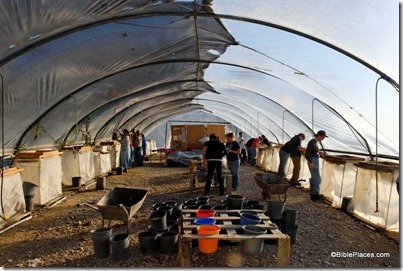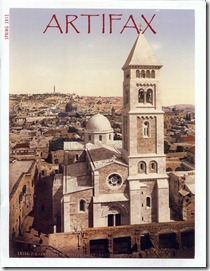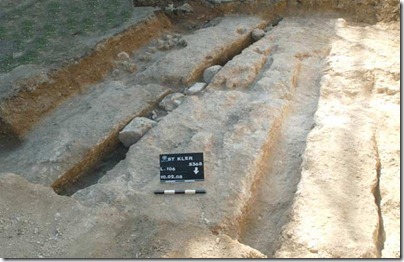From The Temple Mount Sifting Project: On Thursday evening this week, September 6, 2012, the City of David will be hosting their 13th Annual Research Conference sponsored by the Megalim Institute. The program begins with an open house from 16:00 to 18:30 to give you an opportunity to visit the City of David and see all the newly excavated areas including the Second Temple Period street and water channel from the Siloam Pool up to the Temple Mount. The formal part of the program begins at 18:30. Admission is free and no registration is required, but space is limited. During the open house from 16:00 to 18:30, the Temple Mount Sifting Project will host an exhibit of finds recovered during the past 7 years of work. The display, in the courtyard just inside the entry gates of the City of David, will include ancient seals and coins, personal items such as hair combs and jewelry, arrowheads, dice and game pieces, clay idols, weights, Herodian architectural elements and paving tiles that were once part of the Temple Mount plaza. This is the first time that these artifacts have been available for public viewing. Later in the evening as part of the Conference, at about 21:00, we will give a presentation [in Hebrew] of the Sifting Project’s important finds since our last Research Conference report, given in 2007. We will also be updating the public on our ongoing research and our new understandings about the Temple Mount’s past. Please stop by the City of David on Thursday evening to view this amazing exhibit of artifacts that helps tell the history of the Temple Mount. More information about the City of David Archaeological conference is here. HT: Joseph Lauer  Temple Mount Sifting Project
Temple Mount Sifting Project
ARTIFAX Magazine is a little-known secret of biblical archaeology. If you are a member of the Near Eastern Archaeology Society (NEAS), you receive the quarterly magazine as part of your membership. If you do not, it’s quite possible that you’ve never heard of this magazine even though it’s now in its 27th year of publication. In every issue, ARTIFAX provides updates from the world of biblical archaeology, often excerpting articles from the local press of Israel, Jordan, Greece, and other countries. ARTIFAX also features original articles by various scholars, some you’re probably familiar with, and others you may not know. I’ve written several articles for the magazine over the years, and I always find it an interesting read. I don’t think I’ve ever recommended a subscription simply because there’s never been an easy way to subscribe. A new website changes that, and you can now subscribe with a few clicks of the mouse. I encourage you to check it out. 
- Tagged Resources
About half a dozen new excavation reports were published yesterday at the IAA’s Hadashot Arkheologiyot, including three from Jerusalem: Mishkenot Sha’ananim – a section of the Low-Level Aqueduct from the Roman-Byzantine period and an earlier unknown period. This aqueduct brought water from Solomon’s Pools to Jerusalem. St. Claire’s Monastery, Talpiot – a section of the High-Level Aqueduct from the 1st-2nd centuries AD. Zedekiah’s Cave – co-sponsored by the [Ron] Wyatt Museum of Tennessee, this 2011 excavation focused on two areas in the lower level of the cave. Remains were found from the Arab and Crusader periods, but the ark of the covenant was not located. All reports include maps, plans, and photographs. Several other discoveries have been mentioned in recent days: Byzantine-era remains of Jewish town found 9 miles (15 km) north of Beersheba will require the re-routing of Israel’s new north-south toolway. Imported pottery from Cyprus discovered at Tel Burna in the Shephelah has been photographed. A figurine was discovered on the surface of Tell es-Safi/Gath by a student.  Water channel excavated at St. Claire’s Monastery. Photo by IAA.
Water channel excavated at St. Claire’s Monastery. Photo by IAA.
- Tagged Discoveries, Excavations, Jerusalem, Negev, Philistines, Shephelah
The north of Israel received a surprise August rainfall this week. Haaretz has more about the rabbi who was accused of stealing bones from an archaeological site near Beth Shemesh. Israel will return two sarcophagi lids stolen from Egypt. The BBC describes Lidar archaeology and some debate about its value. Joe Yudin recommends the view from an inactive volcano in the Golan Heights. I think that Wayne Stiles somehow managed to get all of my favorite Masada photos in this article. The ABR bookstore is now offering free shipping on all orders over $35. They offer a number of books under $10. HT: Jack Sasson, Paleojudaica  View towards Damascus from Mount Bental (photo source)
View towards Damascus from Mount Bental (photo source)
- Tagged Egypt, Golan, Resources, Shephelah, Syria, Technology, Weekend Roundup
Two Neolithic figurines were discovered at Moza (biblical Emmaus?) along the Jerusalem-Tel Aviv highway. High-res photos from the IAA are available. Two men were arrested for trying to steal bones from excavations in Beth Shemesh. The Israeli government has appealed the verdict in the case of the Jehoash Inscription, but the rationale for doing so is unclear. Shmuel Browns suggests a 10-day itinerary that will take you to many places you won’t see on a typical Christian tour. Stephen Gabriel Rosenberg provides a review of the archaeological stories in July. Aaron’s tomb near Petra is a “quiet, austere holy site.” There is a lot to see in the Kidron Valley of Jerusalem. Accordance 10 has some nice new features for photographs and maps. Now shipping: Alexander to Constantine: Archaeology of the Land of the Bible, by Eric M. Meyers and Mark A. Chancey. HT: Charles Savelle  Neolithic figurine from Moza. Photo by Yael Yolovitch, courtesy of the Israel Antiquities Authority.
Neolithic figurine from Moza. Photo by Yael Yolovitch, courtesy of the Israel Antiquities Authority.
- Tagged Excavations, Jerusalem, Jordan, Judah, Shephelah, Tourism, Weekend Roundup
In an interview posted this morning on Justin Taylor’s blog, Leen Ritmeyer describes the “Palatial Mansion” that overlooked the Temple Mount in the first-century. This impressive structure inside today’s Wohl Museum is frequently skipped by tourists to Jerusalem, if I can judge by the private visits my groups usually enjoy at the site. Many who have been to Jerusalem may thus “see” this ancient home through the Leen Ritmeyer’s eyes, as the supervisor of the reconstruction effort provides a helpful “walk-through.” The house also provides the opportunity to clarify a difficult portion of the New Testament. How could Peter be warming himself by a fire in the courtyard on the night he denied Jesus, and yet be able to “go outside” the house of the high priest (Luke 22:54-62)? Ritmeyer explains and illustrates the concept of an open courtyard inside the palace. While I appreciate the way that Ritmeyer makes these discoveries so accessible to the average Bible reader, I am less optimistic that this particular house is the very house where Jesus stood on trial and Peter denied the Lord. In favor of making this positive identification is the fact that this is the largest house known from this time period in Jerusalem. On the other hand, most of the land in the Old City has never been excavated. If there were 100 houses in Jerusalem in the first century, how likely is it that the only complete one excavated is the same one mentioned in the Bible? See the post for the full interview, some of Ritmeyer’s famous diagrams, and links to his excellent resources. A commenter to the post also shares 63 high-resolution photos he took on a visit. These are particularly valuable because photography is not allowed unless you pay a lot of money.
- Tagged Jerusalem
The BiblePlaces Blog provides updates and analysis of the latest in biblical archaeology, history, and geography. Unless otherwise noted, the posts are written by Todd Bolen, PhD, Professor of Biblical Studies at The Master’s University.
As an Amazon Associate we earn from qualifying purchases. In any case, we will provide honest advice.